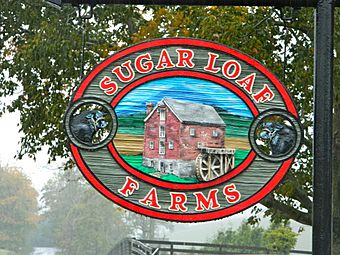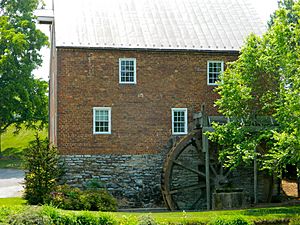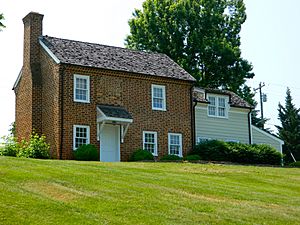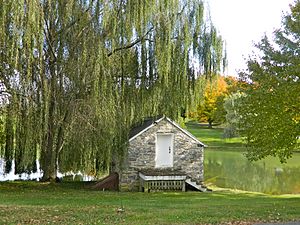Sugar Loaf Farm facts for kids
|
Sugar Loaf Farm
|
|

Sugar Loaf Farm logo
|
|
| Location | Augusta County Virginia, USA |
|---|---|
| Nearest city | Staunton, Virginia |
| Area | 408 acres (165 ha) |
| Built | 1822 |
| Architectural style | Federal |
| NRHP reference No. | 91000884 |
Quick facts for kids Significant dates |
|
| Added to NRHP | July 9, 1991 |
Sugar Loaf Farm is a historic farm in Augusta County, Virginia. It has buildings from the early 1800s. The farm is about 7.5 miles southwest of Staunton, Virginia. It is also near Sugar Loaf Mountain.
Sugar Loaf Farm is listed on the U.S. National Register of Historic Places. It has the only old brick grist mill left in Augusta County, Virginia. A grist mill grinds grain into flour. This mill uses ideas from Oliver Evans, a famous mill designer. Its special brick details show local building styles from the 1800s.
The farm's first three buildings were the farmhouse, the grist mill, and the miller's house. David Summer built them. At that time, Augusta County was a big area for growing wheat and making flour. Sugar Loaf Farm helps us remember this important part of history. Today, it is a private farm that raises Black Angus cattle.
Contents
Farm History
Sugar Loaf Farm gets its name from a special cone-shaped hill on the property. This hill has been a local landmark for hundreds of years. John Summers owned the main part of the farm as early as 1773.
By 1830, John Summers's son, David, had built the three main buildings. These were the farmhouse, the grist mill, and the miller's house. After David Summer died in 1857, the Bowman family bought the farm. They owned it for many years. Since then, Sugar Loaf Farm has had different owners. Today, a large private company that raises cattle owns it.
Building Styles
Sugar Loaf Farm has been a working farm for almost 200 years. Its buildings and the land around them, like fields and streams, work together. The main buildings were all built within ten years. They were planned as a complete set.
Over time, things like family changes and new farming tools affected the buildings. The farm covers about 2200 acres. About 408 acres, including the grist mill, miller's house, and springhouse, are part of the National Register of Historic Places listing.
The Brick Grist Mill
This mill was designed using ideas from Oliver Evans (1755–1819). Evans was a leader in making water-powered mills easier to use. His mills could be run by just one person. They used a continuous production line. You can read about his designs in his book, The Young Mill-Wright and Miller's Guide.
The brick grist mill at Sugar Loaf Farm is a four-story building made of masonry (bricks and stone). Each floor of the mill had a different job. The first floor had controls for the machines. Grinding happened on the second floor. Sifting and storing grain were done on the third and fourth floors. Most of the original mill machines are gone. But the original hurst frame is still there. This part of the mill exactly follows Oliver Evans's design.
The Miller's House
The miller's house and the mill have stayed mostly the same since they were built in the 1820s. The miller's house is a two-story home. It has two rooms on each floor. It has a chimney on the north side with a special corbeled cap (a fancy brick design).
Like the main farmhouse, the miller's house has decorative brick cornice molding (a decorative trim). It also has oak wood around the windows and doors. The layout of the rooms was similar to the main farmhouse, but smaller.
The Stone Springhouse
The limestone springhouse is east of the main farmhouse. It is near Eidson Creek. This creek was the main water source for the farm and powered the grist mill. The springhouse was likely built around the same time as the other main buildings (1820s). Its roof gable and door and window frames look similar to the other buildings.
Images for kids
Today, Sugar Loaf Farm is a family farm. It specializes in raising Black Angus cattle. It is in the beautiful Shenandoah Valley. The farm is an important part of the history and culture of Augusta County, Virginia.
















